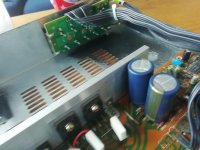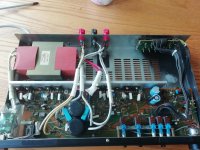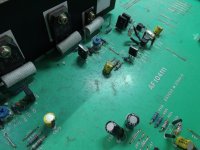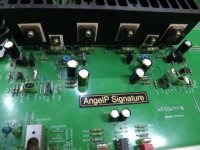16 ohms is a strange value. But if the short disappears and the fuses stop blowing when you isolate the heatsink the problem probably lies there. The heatsink should not conduct any current.
What I would suggest: First with power off
1) Measure the resistance of the trannies' secondary windings. (Should be <1ohm)
- and then with power on, heatsink not touching chassis:
2) Measure the voltage at speaker outputs (Should be in the mV range)
3) Measure the voltage between speaker+ output and heatsink (Should be 0V)
- if it is a high voltage, power off and
4) Measure the resistance between each power transistor collector to the heat sink. (should be infinite or high Mohms)
If R642 (33k) is down to 4ohm, the parallel 5A speaker protection fuse must have been blown and the output stage suffered a huge current load. But even so, 4ohms is also a strange value..
OR - your multimeter or test leads have a fault. We all tend to trust our equipment readouts more than our own judgement.
Just my 2p,
Per
Been busy with other things recently

what is the potential difference between the heatsink and the chassis?
3mv as it is now
I've enjoyed reading this thread for a while and just want to say it's been a pleasure and appreciation to everyone involved.
I bought one back recently as I love the warm sound.
It only cost me £44 and was in superb condition as it was in storage since a few months old.
I have recently recapped it using Panasonic FM/FC and 10000uF Rubycon main filter caps.
I have two queries, is it worth changing the speaker wires (Supra cable) and the mains wire and the mains capacitor to a 0.69uF 250v as I believe the original is 'dodgy' to use in the UK?
I also put a larger volume knob and its not so sensitive. The new caps seem to help keep the amp cooler or I'm I wrong?
I bought one back recently as I love the warm sound.
It only cost me £44 and was in superb condition as it was in storage since a few months old.
I have recently recapped it using Panasonic FM/FC and 10000uF Rubycon main filter caps.
I have two queries, is it worth changing the speaker wires (Supra cable) and the mains wire and the mains capacitor to a 0.69uF 250v as I believe the original is 'dodgy' to use in the UK?
I also put a larger volume knob and its not so sensitive. The new caps seem to help keep the amp cooler or I'm I wrong?
Attachments
Hi Stewart,
The capacitors will not affect the amplifier unless the originals were defective and it was oscillating.
Don't bother replacing the wire. Even if it was "bad wire", there is only a few inches of the stuff compared to wiring outside. If you do anyhow, do not use a larger size such that soldering it to the original locations is dodgy. Really heavy wire can break solder tabs and I've seen 1/2 the conductors cut on wire just to get it installed. So if you really must, a fine stranded very flexible wire the same size or not too much larger. Use good common sense. BTW, very fine flexible wire means it is copper and not steel.
Nice job on your amplifier.
-Chris
The capacitors will not affect the amplifier unless the originals were defective and it was oscillating.
Don't bother replacing the wire. Even if it was "bad wire", there is only a few inches of the stuff compared to wiring outside. If you do anyhow, do not use a larger size such that soldering it to the original locations is dodgy. Really heavy wire can break solder tabs and I've seen 1/2 the conductors cut on wire just to get it installed. So if you really must, a fine stranded very flexible wire the same size or not too much larger. Use good common sense. BTW, very fine flexible wire means it is copper and not steel.
Nice job on your amplifier.
-Chris
Hi Stewart,
That is probably the cleanest old RA-820 I have seen for years!
Yes, you should check the spark quencher cap (C001) as some of these amps have been sold in the UK with a 120V rated type. If so, replace with a X or Y rated safety capacitor of same value but 250V. I use the RIFA PME 217Y series.
I totally agree with Chris about the wiring and I won't even get started on "upgrading" the mains cable. Just remember that the mains ac current eventually passes through narrow switches, fuses and umpteen rounds of fine gauge transformer primary winding.
You could upgrade the input and VAS stages as per this thread, I now have a new batch of CM1 and VAS3 modules ready.
Cheers,
Per
That is probably the cleanest old RA-820 I have seen for years!
Yes, you should check the spark quencher cap (C001) as some of these amps have been sold in the UK with a 120V rated type. If so, replace with a X or Y rated safety capacitor of same value but 250V. I use the RIFA PME 217Y series.
I totally agree with Chris about the wiring and I won't even get started on "upgrading" the mains cable. Just remember that the mains ac current eventually passes through narrow switches, fuses and umpteen rounds of fine gauge transformer primary winding.
You could upgrade the input and VAS stages as per this thread, I now have a new batch of CM1 and VAS3 modules ready.
Cheers,
Per
Hi Per
Really appreciate your reply and guidance and will absorb all your advice.
I will leave the mains cable alone. I will see which safety caps I have at home later as I have a small collection yet not experienced changing those before and want to be sure.
It is so clean, apparently the one previous owner shrink wrapped it while in storage to keep dust out. I've not even Deoxited yet but will when I'm finished.
I will continue to study this post and do as much as possible and get those modules from you when the time comes.
I have much more expensive modern amps yet can't help using this one.
How about the loudspeaker cables? From what I understand the indulgence is no good. I have QED silver cable from amp to Seas drivers with preferred differences. I'm not caught up on cables yet if its worthy I'll replace them and heat shrink them too
I found additional support of the circuit board to have a surprising more stable sound, not much but it helps
Thanks again
Really appreciate your reply and guidance and will absorb all your advice.
I will leave the mains cable alone. I will see which safety caps I have at home later as I have a small collection yet not experienced changing those before and want to be sure.
It is so clean, apparently the one previous owner shrink wrapped it while in storage to keep dust out. I've not even Deoxited yet but will when I'm finished.
I will continue to study this post and do as much as possible and get those modules from you when the time comes.
I have much more expensive modern amps yet can't help using this one.
How about the loudspeaker cables? From what I understand the indulgence is no good. I have QED silver cable from amp to Seas drivers with preferred differences. I'm not caught up on cables yet if its worthy I'll replace them and heat shrink them too
I found additional support of the circuit board to have a surprising more stable sound, not much but it helps
Thanks again
Hi Stewart,
Please do not experiment with just "any old replacement" for the the spark killer cap C001. Only use a proper X or Y rated, self healing, safety cap.
I also now see that you suggest a 0.69uF - IMHO that is quite high, Rotel normally use 4n7 for this. I would suggest PME271Y472M, you can buy it cheaply on CPC, code CA06038. And also safely refit the plastic cover on the switch pcb when you're done.
Your general amp recap in itself most probably did not make it run any cooler unless there was some prior instability. Did you adjust the bias currents after the recap?
Oh, and please don't spray de-ox stuff into such clean pristine pots. Leave that for much later when they get grubby and horrible and need it.
Cheers,
Per
Please do not experiment with just "any old replacement" for the the spark killer cap C001. Only use a proper X or Y rated, self healing, safety cap.
I also now see that you suggest a 0.69uF - IMHO that is quite high, Rotel normally use 4n7 for this. I would suggest PME271Y472M, you can buy it cheaply on CPC, code CA06038. And also safely refit the plastic cover on the switch pcb when you're done.
Your general amp recap in itself most probably did not make it run any cooler unless there was some prior instability. Did you adjust the bias currents after the recap?
Oh, and please don't spray de-ox stuff into such clean pristine pots. Leave that for much later when they get grubby and horrible and need it.
Cheers,
Per
ac and dc?
I've replaced most of the capacitors since and now there is no reading, ie zero, dc & ac but my DMM lowest setting on AC is 200v!
I've replaced most of the capacitors since and now there is no reading, ie zero, dc & ac but my DMM lowest setting on AC is 200v!
Ok, if there's no ac or dc potential difference - no current can flow.
So, from what you have tried I doubt that you have a shorting issue between heat sink and chassis, but rather some serious instability / oscillation - which indeed can blow fuses just like a short.
Did you try the 100p Miller caps on the VAS'? Have you put a scope on the output?
Yes, sometimes you do tear your hair out over these things - and I for one don't have much left!
Per
Thanks again Per for your great advice.
I will order that cap as you suggested. Better get it right
I didn't adjust the bias as my friend has borrowed my multimeter sorting out his amplifier but will do the bias next time I open it up
Your tips are much appreciated and can't thank you enough
I will order that cap as you suggested. Better get it right
I didn't adjust the bias as my friend has borrowed my multimeter sorting out his amplifier but will do the bias next time I open it up
Your tips are much appreciated and can't thank you enough
Hi Stewart,
Be aware that bias current is an approximate setting. It varies with temperature and AC supply voltage. Not only that, but your meter would have to show the mV scale to 2 decimals past the units place if your reading are to be accurate. So only touch the bias current if the readings are well out of specification. Most cheaper meters are not accurate at all in the mV scales. You would at least need a 20 mV scale. A 200 mV scale with a 3 1/2 digit meter will not be accurate at all. Take time to read the accuracy specs for your meter and figure it out to a voltage range. Many meters are out of tolerance even when brand new.
-Chris
Be aware that bias current is an approximate setting. It varies with temperature and AC supply voltage. Not only that, but your meter would have to show the mV scale to 2 decimals past the units place if your reading are to be accurate. So only touch the bias current if the readings are well out of specification. Most cheaper meters are not accurate at all in the mV scales. You would at least need a 20 mV scale. A 200 mV scale with a 3 1/2 digit meter will not be accurate at all. Take time to read the accuracy specs for your meter and figure it out to a voltage range. Many meters are out of tolerance even when brand new.
-Chris
Well, I currently have 7 Rotels that await a full upgrade. There's actually one on eBay at the mo, just search 123810141157.
They seem to fly out of the door as soon as I finish them. Even the original RA-820AX from this thread got picked up.
Not that I am making a fortune - eBay and PayPal are doing that - I just find the amp rescue work quite therapeutic and very satisfying that the eventual users get so much joy out of it - perhaps a bit like restoring a classic car. And the wife says it keeps me off the street corners.
Anyway, here's two "before and after" pics. Cosmetically you could call it "barn find" to "concourse level" - but regarding audio quality it is more like "beam me up".
Per
They seem to fly out of the door as soon as I finish them. Even the original RA-820AX from this thread got picked up.
Not that I am making a fortune - eBay and PayPal are doing that - I just find the amp rescue work quite therapeutic and very satisfying that the eventual users get so much joy out of it - perhaps a bit like restoring a classic car. And the wife says it keeps me off the street corners.
Anyway, here's two "before and after" pics. Cosmetically you could call it "barn find" to "concourse level" - but regarding audio quality it is more like "beam me up".
Per
Attachments
Fantastic Chris and I completely understand why you modify the equipment as its happy for all involved. So good to see you helping others and I'm sure they are more than happy with your tweaked gear.
I feel lucky as I have a personal friend locally that I have worked with building some superb Seas loudspeakers, I am more knowledged in loudspeakers and PA stuff yet now well into the electronics. I went to college in electronic engineering but unfortunately couldn't finish the course due to my car detailing business growing, hence I agree about the restoration of classic cars haha
I'll show my friend your gear on ebay, he has an old Arcam system yet not keen on modifying the front end equipment so I feel he will be interested alot
I feel lucky as I have a personal friend locally that I have worked with building some superb Seas loudspeakers, I am more knowledged in loudspeakers and PA stuff yet now well into the electronics. I went to college in electronic engineering but unfortunately couldn't finish the course due to my car detailing business growing, hence I agree about the restoration of classic cars haha
I'll show my friend your gear on ebay, he has an old Arcam system yet not keen on modifying the front end equipment so I feel he will be interested alot
Hi Stewart,
I think you meant Per (AngelIP). The Rotel equipment I run into is owned by customers only. What I do overhaul and improve are mostly Marantz, Counterpoint and other high end brands. I never know what is going to arrive next.
I used to sell test instruments as well, so I've had a lot of exposure to both the instrumentation I use, and the equipment I repair. I also used to sell electronic components early in my career, so I got to know the differences between them at an early age. All those early jobs did combine to make me a better technician.
-Chris
I think you meant Per (AngelIP). The Rotel equipment I run into is owned by customers only. What I do overhaul and improve are mostly Marantz, Counterpoint and other high end brands. I never know what is going to arrive next.
I was an electronic instrument calibration technician (Journeyman level) for a time. I saw an awful lot of unpleasant realities in the world of test equipment. I can boil things down to this. If what you measure is important (even if you only measure one thing but it is important), use a very good brand of meter and make certain it is in tolerance.. So that means no economy meters. You're limited to Keysight, Fluke and Kiethly. Not much else will hold a calibration, yet these brands will hold cal for years on end as long as you don't do anything stupid with them. I didn't include lab meters as they are not well suited to servicing. For example, the HP/Agilent/Keysight 3458A meter is a standard asset in many labs. It would be used to calibrate other meters and voltage references. It would be very frustrating to use on a service bench.That is great information about the meter, I didn't know all this and will be much needed knowledge
I used to sell test instruments as well, so I've had a lot of exposure to both the instrumentation I use, and the equipment I repair. I also used to sell electronic components early in my career, so I got to know the differences between them at an early age. All those early jobs did combine to make me a better technician.
-Chris
Yes I'm sorry I was rushing last night. I should make time to reply correctly. Apologies
I've been looking at those meters as your advice is very interesting Chris
I also have some poly caps spare I was thinking of replacing the 1uF multi-stacked capacitors with (not sure if that's the name) yet they seem to last and are stable. I have Claritycap ESA 4uF and 6. 8uF in pairs if you guys think it's worthy?
I've been looking at those meters as your advice is very interesting Chris
I also have some poly caps spare I was thinking of replacing the 1uF multi-stacked capacitors with (not sure if that's the name) yet they seem to last and are stable. I have Claritycap ESA 4uF and 6. 8uF in pairs if you guys think it's worthy?
Hi Stewart,
The first question about your capacitors would be, do they fit properly? They most likely do not, and if this is the case you should abandon those plans. The iuF poly caps are stable and will last a long time. They are good replacements for Electrolytic capacitors. There is no need to increase the capacitance at all. In general, your best bet is to try and stay with the same capacitance that was in there to start with. You can use a 1 uF to replace a 0.82 uF, only because that is an odd value and the 1 uF capacitor is very close to being the same size.
-Chris
The first question about your capacitors would be, do they fit properly? They most likely do not, and if this is the case you should abandon those plans. The iuF poly caps are stable and will last a long time. They are good replacements for Electrolytic capacitors. There is no need to increase the capacitance at all. In general, your best bet is to try and stay with the same capacitance that was in there to start with. You can use a 1 uF to replace a 0.82 uF, only because that is an odd value and the 1 uF capacitor is very close to being the same size.
-Chris
- Home
- Amplifiers
- Solid State
- Improve a Rotel amp THD by 20dB!




